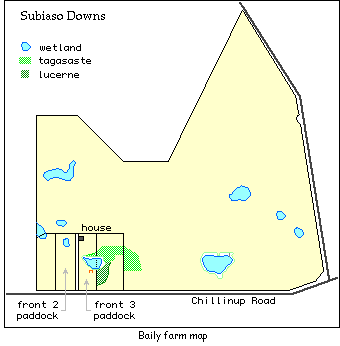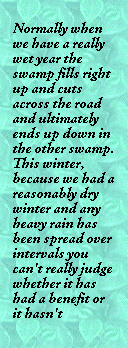
James and Joan Baily, Subasio Downs, Gnowellan

|
Ephemeral wetland protection: Front 2 paddock wetland
James and Joan Baily, Subasio Downs, Gnowellan |
 |
 The Site
The Site
Jim and Joan Baily were managers of Subasio Downs from the mid 1970s until the end of 1999. The farm is situated 110 kilometres northeast of Albany in the district of Gnowellan. Eight ephemeral wetlands occur in depressions on the property and they range in size from two to seven hectares. Some are saline and some relatively fresh. There are no defined creeklines and the catchments for each wetland are local. The original vegetation in and around the wetlands was Yate (Eucalyptus occidentalis), paperbark (Melaleuca), pigface (Carpobrotus), chittick (Lambertia), hakea, banksia and some native saltbush (Atriplex). The land was allocated to farming in 1957 and the majority of development occurred between the early 1960s and early 1980s. All eight wetlands have been fenced starting in 1993 with the last one being completed in 1999. The topography is very flat with soils mainly comprising sand over gravel and sandy gravels over clay. This wetland is situated in Location 6214 in 'Front paddock 2' and is approximately 2.5 hectares in area. The Problem The wetland has a dam constructed in it and contains potable water with no signs of salt encroachment, and supplies water to the house and gardens. It only fills during wet years. The area is very awkward to crop and has sandy soil that is susceptible to wind erosion, especially with the strong northwesterly winds which "tunnel" through there. Because of the above reasons the site was a very convenient one on which to establish a tree trial and the Bailys wanted to ensure that good quality water would be available into the future.
In 1992 Greening Australia supplied a mixture of tree and shrub seedlings for the area, though unfortunately high rabbit numbers were a problem with only the acacias surviving. A successful 1080 baiting program was then carried out. A woodlot was established in 1998 in cooperation with Green Scene Nursery (Esperance) and Timber 2000 (Albany). The aim was to trial tree species suitable to dry areas with the potential for value adding. In early August 1998 an area of five hectares was planted with mixed eucalypts and acacias on a badly windblown area that was not suitable for cropping. Prior to planting the area was ripped to a depth of 0.75 to 1 metre and sprayed for weed control with "Roundup" and "Simazine" with excellent results. The trees were planted four metres apart with five metres between rows at 1000 stems per hectare. No pesticides were necessary at this site post planting as there was an excellent build-up of predator insects and the Bailys preferred to let "nature take its course". Some of the Eucalyptus camaldulensis were attacked by the leaf blister saw-fly but they seemed to survive the infestation without interference. About 25% of the area planted was inundated for six months during the wet year of 1998. Despite this the majority of seedlings survived and those that didn't have been replaced. Some planting on mounds was carried out in 1999 to help alleviate any inundation problems in the future. After the herbicide treatment the annual legume serradella (Ornithopus species) didn't grow during the winter. However, after the following wet spring when the herbicide residues had disappeared from the soil it started growing again. Although it almost swamped the tree seedlings, the Bailys thought that to some extent it provided protection for the seedlings as well as providing an excellent source of nitrogen. The other main weed infestations at the site were melons, wire weed, South African lovegrass and deadly nightshade. These were hand weeded from around the trees and hand sprayed with "Roundup" (250 millilitres/15 litres approximately). The Bailys estimate that they had about a 90% survival rate of the seedlings using the above methods. In addition to the tree trial the Bailys wanted to establish a wildlife corridor to link the plantings around the house to the wetland. During 1999 Greenskills erected one kilometre of electric fencing (2 power/2 earth wires) around the southern side of the wetland and remnant vegetation. This completed the wetland fencing program for the farm. Outcomes and observations The Bailys have looked at the possibility of value adding with the planting program around this wetland. Some of the possibilities are construction, fine furniture and craft timber, honey production, fence posts, aromatic and essential oils, cut flowers, adhesives, firewood, charcoal products, gums, resins and dyes, tannin, plywood and stock fodder. "The biggest battle, apart from planting trees for commercial purposes, is the time. Oil mallees will be a big positive for this area and we'll be achieving landcare as well". "It is difficult to judge the benefits for the wetland at this stage as the trees have only been in for two years. Normally when we have a really wet year the swamp fills right up and cuts across the road and ultimately ends up down in the other swamp. This winter, because we had a reasonably dry winter and any heavy rain has been spread over intervals you can't really judge whether it has had a benefit or it hasn't". "Certainly the trees are doing well and would have done far better if we could have got down to spray the weeds. The weeds have tended to take over, it's been unfortunate that we've had a fairly windy year and of course you've got to judge your spray time". The Bailys have noticed that the yate trees weren't affected to the same degree by lerp infestation in the wetlands that have been fenced off for a number of years and have had a chance to recover. In contrast the yate trees in this wetland, which was only fenced off in 1999, had a very bad lerp infestation the same year. The Bailys have also undertaken some trialing of different provenances of plants and some mounding (to alleviate the effects of inundation) this year. It will be some years before the results of these trials are known. Farm statistics
Wetland Catchment Statistics
Map Reference: 1:50 000 2629 II and 2529 II, Plantagenet Locations 6209, 6214, 6215 and 6223 |
||||||||||||||||||||||||
 |
|||||||||||||||||||||||||
 |
|||||||||||||||||||||||||